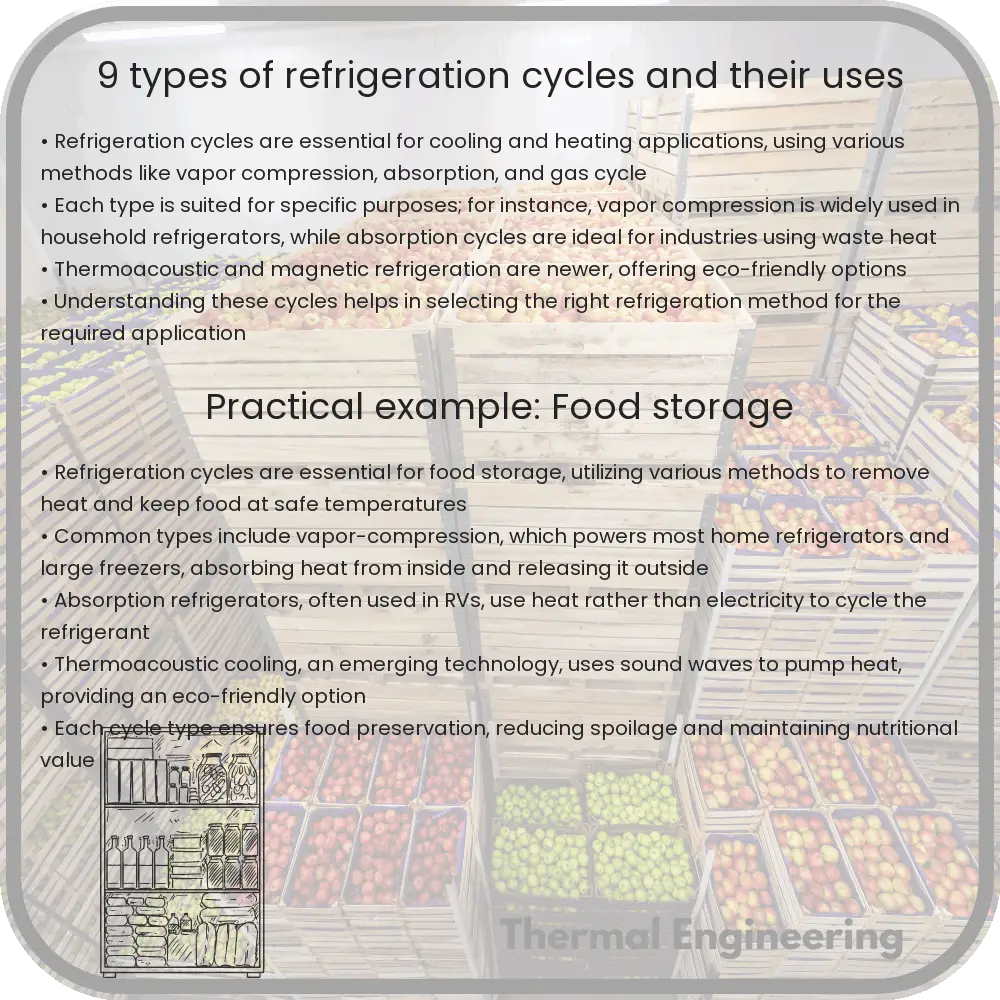Learn about various refrigeration cycles, their processes, and applications in cooling systems, from household units to industrial plants.

Introduction to Refrigeration Cycles
Refrigeration cycles are the backbone of cooling systems found in everything from household refrigerators to industrial cooling plants. These systems employ a sequence of thermodynamic processes to remove heat from an area and dispel it elsewhere. Understanding the different types of refrigeration cycles can help in choosing the appropriate system for specific cooling needs.
Types of Refrigeration Cycles and Their Uses
There are several types of refrigeration cycles, each with unique characteristics and applications. Here are nine of the most common cycles:
- Vapor Compression Cycle
The most widely used method for air conditioning of buildings and automobiles is the vapor compression cycle. It involves four key processes: compression, condensation, expansion, and evaporation. The cycle works by compressing a refrigerant, then condensing it from a gas to a liquid by removing heat through a heat exchanger, expanding it to reduce pressure, and finally evaporating it to absorb heat from the enclosed area.
- Absorption Refrigeration Cycle
Unlike vapor compression, the absorption refrigeration cycle uses a heat source, such as natural gas or solar energy, to operate. The cycle absorbs heat into a liquid refrigerant, which is then evaporated to produce cooling. This cycle is particularly useful for industrial applications where waste heat is readily available.
- Vapor Absorption Cycle
This cycle is similar to the absorption refrigeration cycle but typically uses water as the refrigerant and a lithium bromide solution as the absorbent. It is very effective in air-conditioning systems where electrical power is limited or expensive.
- Gas Cycle
Used mainly in cryogenic applications, such as air liquefaction, the gas cycle uses helium or hydrogen as a refrigerant. The process involves compressing the gas, cooling it through expansion, and then repeating the cycle.
- Stirling Cycle
The Stirling cycle is known for its high efficiency in comparison to other cycles. It is used in both cooling and heating applications and works by cyclically compressing and expanding a fixed mass of gas at different temperature levels.
- Ejector Cycle
This cycle uses a jet of steam or gas to carry the refrigerant. The ejector cycle is often used in systems where reliability and simplicity are more critical than efficiency, such as in some types of air conditioning and refrigeration systems on ships.
- Rotary Vane Cycle
A rotary vane compressor is at the heart of this cycle, which is commonly used in automotive air conditioning systems. The compressor pressurizes the refrigerant, which then circulates through the system to absorb and remove heat from the cabin.
- Screw Compression Cycle
Similar to the rotary vane cycle, the screw compression cycle uses a screw compressor for the compression of the refrigerant. This type of cycle is typically used in larger industrial air conditioning and refrigeration systems due to its capability to handle large volumes of refrigerant.
- Centrifugal Compression Cycle
Centrifugal compressors are used in this cycle, making it most suitable for very large applications such as industrial chilling plants and large commercial air conditioning systems. The refrigerant is compressed by the centrifugal force exerted by a spinning impeller.
Conclusion
Refrigeration cycles are fundamental to a wide range of cooling applications, from simple household devices to large-scale industrial systems. Each type of cycle offers distinct advantages and is suited to particular applications. By understanding these differences, engineers can design more efficient and appropriate cooling systems tailored to specific needs.